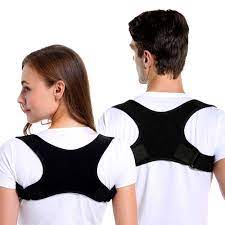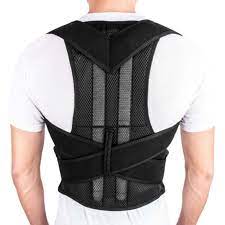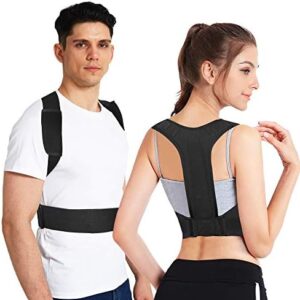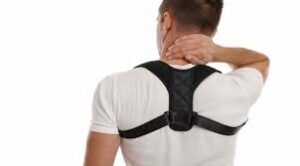

Proper neck alignment while sitting is essential to maintaining spinal health and preventing discomfort or long-term musculoskeletal issues.
One effective tool for promoting good posture and neck alignment is the use of a posture corrector strap.
By understanding how to position and use this strap effectively, you can improve your posture, reduce strain, support overall spinal health and learn how to fix posture neck hump.
This article provides a step-by-step guide on using a posture corrector strap for optimal neck alignment, along with essential tips, scientific insights, and practical considerations to ensure effective use.
Points Covered in this Article
- Introduction to Neck Alignment and Posture Corrector Straps
- Why Neck Alignment Matters While Sitting
- Selecting the Right Posture Corrector Strap
- Step-by-Step Guide to Positioning the Strap
- Additional Tips for Effective Use
- The Science Behind Posture Corrector Straps and Neck Health
- Benefits of Maintaining Proper Neck Alignment
- Potential Challenges and Considerations
- Conclusion
Introduction to Neck Alignment and Posture Corrector Straps
Posture corrector straps are the superheroes of the posture world, stepping in to save your neck and upper back from the evils of slouching.
These handy devices are designed to gently pull your shoulders into alignment, encouraging an upright posture and supporting the natural curve of your cervical spine.
When used correctly, they can work wonders in reducing neck strain, easing discomfort, and even preventing long-term issues like “tech neck.”
Picture this: Alex, a graphic designer, spends eight hours a day hunched over his desk. By mid-afternoon, his neck feels like it’s been carrying the weight of the world. Enter the posture corrector strap.
Alex wears it for a couple of hours daily and notices his shoulders staying back naturally, even without the strap.
He ensured to learn how to wear a posture correction devise correctly to fix his neck posture fast.
Or take Priya, a student, burning the midnight oil with her head buried in books.
A posture strap helps her maintain proper alignment, keeping her back happy during marathon study sessions.
Whether you are working, studying, or driving, a posture corrector strap is like having a posture coach on standby—encouraging you to sit up straight and helping you combat the toll of long hours spent sitting.
It is a small tool with big benefits for your spine!
Why Neck Alignment Matters While Sitting?
Maintaining proper neck alignment is not just about looking poised—it is a key strategy to prevent the dreaded “tech neck”, a modern-day epidemic caused by spending hours with your head jutted forward.
This forward head posture places undue strain on the cervical spine, leading to neck discomfort, tension headaches, and in severe cases, chronic pain that can ripple through your upper back and shoulders.
Sitting for long hours only worsens the issue. The body naturally gravitates toward slouching or leaning forward, dragging your neck and head out of alignment.
This misalignment is more than just a cosmetic problem—it overworks your neck’s muscles and ligaments, creating a vicious cycle of tension and fatigue.
Achieving proper neck alignment while sitting comes with incredible benefits:
- Head-Spine Balance: Your head feels lighter when stacked directly over the spine.
- Muscle and Ligament Relief: Proper alignment reduces strain on cervical tissues.
- Optimized Breathing: An upright posture ensures your diaphragm works efficiently, improving breathing and blood circulation.
In short, proper neck alignment is the foundation for a comfortable, pain-free sitting experience and a healthier spine in the long run.
Selecting the Right Posture Corrector Strap
Selecting the right posture corrector strap is crucial for achieving the best results and ensuring comfort. Here are key factors to consider:
- Adjustability: Look for a strap with adjustable components to customize the fit according to your body size and needs. A well-fitted strap provides optimal support without causing irritation or discomfort.
- Material Quality: Choose breathable, lightweight, and durable materials. High-quality materials reduce the risk of skin irritation and ensure that the strap can be worn comfortably for extended periods.
- Targeted Support: Some posture correctors are specifically designed for neck and upper back alignment. These options are particularly effective for alleviating neck strain and promoting proper posture.
- Ease of Use: Opt for a device that is simple to put on, adjust, and remove without requiring assistance.
Additionally, consulting with a physical therapist or healthcare provider can help you select a strap that suits your unique anatomical and postural requirements, ensuring the best outcomes.
Step-by-Step Guide to Positioning the Strap
Proper positioning of a posture corrector strap is crucial for ensuring its effectiveness.
Follow these steps to position the strap correctly:
Step 1: Familiarize Yourself with the Device
Read the instructions provided by the manufacturer to understand the design and functionality of your posture corrector.
Step 2: Loosen the Straps
Before wearing the strap, loosen all adjustable components. This will make it easier to put on and position correctly.
Step 3: Wear the Strap
Place the strap over your shoulders like a backpack. Ensure the back support panel (if present) rests flat against your upper back.
Step 4: Adjust the Shoulder Straps
Gently tighten the shoulder straps to pull your shoulders back slightly. This promotes an open chest posture and prevents slouching. The tension should be firm but comfortable, allowing for natural movement.
Step 5: Check Neck Alignment
With the strap in place, check your neck’s position. Your ears should be aligned with your shoulders, and your head should not tilt forward. Adjust the strap further if needed to achieve this alignment.
Step 6: Secure the Fit
Once you’ve achieved proper alignment, secure any fastenings to maintain the tension. The strap should feel snug but not restrictive.
Step 7: Practice Good Sitting Posture
While the posture corrector provides support, it’s essential to consciously maintain good posture. Sit with your back straight, feet flat on the floor, and your hips aligned with your shoulders.
Step 8: Reassess and Adjust
Periodically check the strap’s fit, especially if you shift positions or engage in different activities. Adjust as needed to maintain proper alignment.
Additional Tips for Effective Use
To get the most out of a posture corrector strap, it is essential to use it thoughtfully and strategically.
Here are some practical tips:
- Start Slowly: Ease into using the strap by wearing it for just 10–15 minutes a day initially. This gradual approach allows your body to adjust without overloading your muscles. Over time, you can increase the duration as your posture improves.
- Combine with Exercises: Pair the strap with exercises that strengthen your upper back and neck muscles. Moves like rows, chin tucks, and scapular retractions help build the necessary muscle support for maintaining proper posture on your own.
- Don’t Overuse: Think of the strap as a training tool, not a crutch. Over-reliance can weaken your postural muscles, defeating the purpose. Aim to use the strap as a supplement, not a permanent fix.
- Stay Consistent: Consistency is the magic ingredient for success. Wear the strap regularly, particularly during prolonged sitting sessions, to reinforce good habits and see lasting improvements in your posture.
With these steps, your posture strap becomes an effective ally in your journey toward better alignment and comfort.
The Science Behind Posture Corrector Straps and Neck Health
Ever wonder how posture corrector straps actually work their magic?
It is all about proprioceptive feedback—a fancy term for your body’s way of recognizing its position in space. Essentially, the strap acts like a gentle reminder, nudging you to straighten up whenever you start to slouch.
A 2022 study published in Clinical Biomechanics found that devices designed to encourage shoulder retraction and spinal alignment can significantly reduce strain on the cervical spine.
This means less pressure on your neck muscles and ligaments, which is great news if you have been battling neck discomfort or that dreaded “tech neck.”
By keeping your shoulders back and your neck aligned with your spine, these straps help distribute the weight of your head more evenly.
This reduces the workload on overburdened muscles and prevents the forward head posture that can lead to long-term complications.
It is a simple tool with a big payoff for neck health!
Benefits of Maintaining Proper Neck Alignment
A posture corrector strap can be a game-changer for neck health, offering a range of benefits that go beyond just sitting straighter:
- Reduced Neck Pain: When your cervical spine is properly aligned, the strain on neck muscles and ligaments is minimized, which helps relieve discomfort and prevent tension from building up.
- Improved Breathing: Good posture is not just about your spine—it impacts your diaphragm, too. When you sit upright, your lungs can expand more fully, making breathing easier and more efficient.
- Enhanced Focus: Neck and shoulder tension can be distracting, even if you do not realize it. Alleviating this discomfort allows you to concentrate better, whether you are working, studying, or simply enjoying leisure activities.
- Prevention of Long-Term Issues: Consistently maintaining proper posture reduces the risk of chronic problems like cervical disc herniation, tension headaches, and muscle imbalances that develop over time.
Incorporating a posture corrector strap into your routine can provide immediate relief while also laying the groundwork for a healthier, more comfortable future.
It is a small investment with significant returns for your overall well-being!
Potential Challenges and Considerations
While posture corrector straps offer significant benefits, they come with a few limitations that users should keep in mind:
- Temporary Discomfort: When you first start using a posture corrector, you might experience mild soreness in your back or shoulders as your body adjusts to the new alignment. This is a natural response as underused muscles are engaged. A study in Physiotherapy Theory and Practice (2020) noted that initial discomfort is common but diminishes as the muscles adapt.
- Over-Reliance: Using a posture corrector for extended periods can lead to weakened postural muscles, as the device takes over some of the stabilizing work. To avoid this, experts recommend pairing the strap with exercises like scapular retractions and planks to strengthen supporting muscles.
- Individual Variability: The effectiveness of posture corrector straps can vary depending on individual anatomy and the severity of posture issues. A 2021 review in Ergonomics highlighted that while some individuals see significant improvements, others may require additional interventions.
Moreover, posture corrector straps should complement an ergonomically optimized workstation.
Ensuring proper chair height, desk setup, and monitor positioning is crucial for maintaining overall posture and preventing strain.
These adjustments work in tandem with the strap for long-term postural health.
Conclusion
Using a posture corrector strap for neck alignment is a simple yet powerful way to combat poor posture and reduce its associated health risks.
Proper positioning of the strap ensures that your shoulders and neck are aligned, helping to alleviate neck strain, prevent tension buildup, and promote better overall posture.
By following a step-by-step guide and adopting best practices, you can enhance your sitting posture, reduce discomfort, and improve your quality of life.
However, it is essential to remember that a posture corrector strap is a training tool, not a permanent fix.
To achieve long-term results, pair its use with regular strengthening exercises, such as lat pulldowns and chest stretches, to build muscle support.
Additionally, make ergonomic adjustments to your workstation, like ensuring proper chair height, using saddle chairs for fixing neck posture and monitor positioning.
With consistent use and the right approach, you can maintain proper neck alignment, enjoy greater comfort, and support better spinal health in your daily activities.
References:




